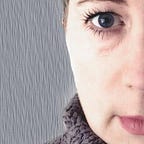Art+Tech @ VAR Gallery [ Milwaukee, WI ]
Reading information on computer screens means using one’s eyes to scan, read, and task-switch to “watching” for video, “looking at” for images. Many of the choices that we make are unconscious, quick responses to the cues provided by the dynamic screen. I went to the opening of an art show at a gallery and I find myself considering art in that zone of motion and stillness. At first, I look at a still image, one that implies motion.
The eye trained to scan, the eye that reads backlit text by jumping around on the screen, reads Cera’s Remote Anonymity easily. I don’t need to rest on any one ‘face’ to ‘get’ the accumulation of faces. Stepping back and looking — the whole cloud of faces fits comfortably into 18" shape on the larger paper — the whole echoes up in macrocosm from microcosm of face-as-mark. The word ‘anonymity’ in the title tilts us to surveillance mindset.
I attended the opening of Art+Tech at Milwaukee’s VAR gallery last Friday. As I took in the work, I realized I had walked into a show that embodies an animated .gif. Each piece is in motion, or references motion, or waits to be put in motion, or is paused.
Cera’s Remote Anonymity, as a still image, reads as a pause. I read ‘procedurally generated’ as ‘I used code to help create this artwork’. I’m an artist who uses code or software to create; this work reads as a “capture from a moving process”. I could be wrong. Another visitor commented to me that she was curious. “What’s the procedure?”
The cloud of heads referencing accumulation of mark easily manufactured by a computer, the title referencing surveillance, the metallic paper reflecting back to the viewer, the faces looking out at the viewer . . .Does the procedure matter?
Digital-mechanical works like Maksym Prykhodko’s SHOUT, an interactive installation, and Pete Prodoehl’s NoiseMakers (two of which are pictured here) invite viewer participation. We have to yell (for SHOUT) or push buttons to get the art to ‘do something’ for us. Playful, engaging, I couldn’t get a good snapshot of SHOUT during the opening, as people were blocking the view of the work by using it. There’s a conundrum for re-presenting an artwork online… You might just have to go to Prykhodko’s demo this Friday at the gallery.
Where Prodoehl’s pieces invite the viewer to jump-start them through physical interaction, physical computing drives Adam Wertel’s kinetic sculpture. Peek around the side and observe magnets and a drawing arm. On the front of the paper we get a zen drawing, a drawing that makes itself. The piece draws an entire circle; at this packed opening I could but snapshot the half with my phone, in order to assemble the gif today.
Movement and stillness, this piece becomes an index for the show. It invites waiting from the viewer and gives us a peek behind its curtain. Yet from across the room one can see the whole in a single moment.
Nathaniel Stern’s work with printmaker Jessica Ganger didn’t reproduce well for this review. Short loops of video (shown in video pictureframes) illuminate and interact with prints impressed on mulberry paper laid on top. We can sort out the drawing relates to the loop, but how? Wait, does that even matter? Look, motion-and-stillness, and the video’s color and how it informs each print’s static lines. The videos feel like Vine or Instagram videos cut from a larger unknown narrative. Printmaking’s workspace as a crucible of illustration pulled the work towards “unknown larger story” as well. The abstraction provided by the overlay — it’s an elegant combination, as the prints provided a filter, abstracting the video to moving colorforms.
Curators Becky Yoshikane and Cristina Ossers placed Alycia Griesi’s prints in space farthest from the front door of VAR’s gallery. These images, scaled like paintings, operate in the language of digital media. I enjoyed the simplest looking at these images. I looked not to figure out ‘what this is supposed to be’, but to explore the plasticity of form shifting between imagined planes in each broken-image inch or two. Ah, Cezanne, oh cubism, ah glitch art. Love that clinical green. Apparently these are scans of created objects; does it matter? If there’s any place that it’s OK to not know what’s going on, it’s while looking at art. Here, in the space farthest from the door, I’ve traversed from certainty — press the button on Pete Prodoehl’s NoiseMaker and it will make a sound — to not-knowing, visually exploring.
What work haven’t I discussed? Morehshin Allahyari’s movement-in-stillness video piece of iconographic 3D objects hovering; Bryan Cera’s 3D-printed sculpture; other animation work in the space, and and and . . .Wait — there was a performance, too —
Kevin Schlei codes instrument software, primarily for iOS. On view in the gallery are screencaps of his software in use. They’re beautiful flat colors with the familiar logic of geometries for ‘oh the fingertips probably rest in those spots’. They loop me back to the thought, this is a pause in the larger motion of the activity of this art.
Coded software is another node on the Art+Tech landscape. Kevin and I had a neat side conversation on this point; how, the nuts and bolts matter, but the user — or the audience — is simply interested in the experience. While we can peek behind the curtain of Adam Wertel’s sculpture, or find out how Alycia Griesi manufactured her images, so what?
Art and Tech is on view through February 3rd at Var Gallery. Other reviews are at Nathanial Stern’s site and Kat Kneevers for Milwaukee’s Shepherd Express.
